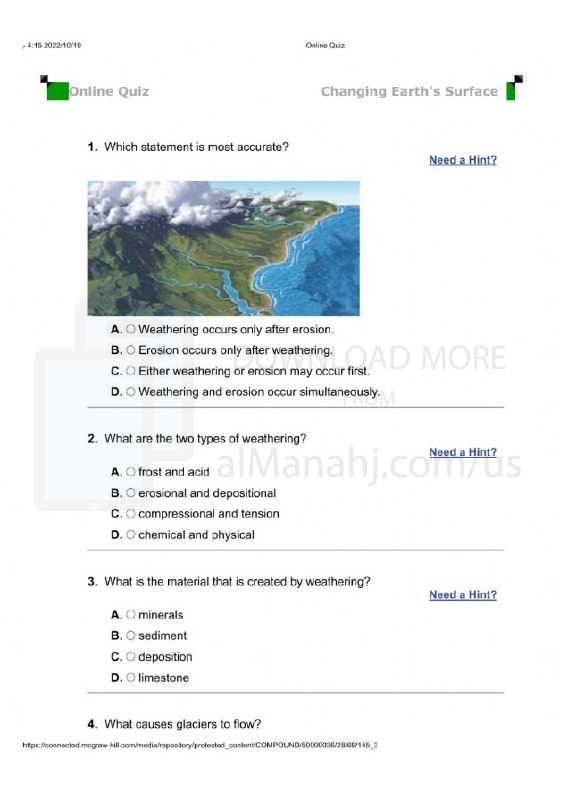| You are here: Almanahj Website ⇒ American curriculum ⇒ 10th Grade ⇒ Geology ⇒ Term 1 | ||
|---|---|---|
Worksheet about Changing Earth's surface | ||
|---|---|---|
| Subject: Geology | ||
| 10th Grade | ||
| Term 1 | ||
| Year: 2023/2024 | ||
| Size: 315KB | ||
| Number of clicks: 152 | ||
| Publish date:November 27, 2023 | ||
| Added by: Eman | ||
| Last download date: 2024-09-11 02:38:32 | By: theodor eslamahmedkhalil | |
| File info: The Earth's surface is constantly changing due to a variety of natural processes and human activities. Here are some of the key factors that contribute to the changing Earth's surface: 1. Plate Tectonics: The Earth's lithosphere is divided into several large and small plates that are constantly moving. Plate tectonics is the process by which these plates interact, leading to the formation of mountains, volcanoes, and earthquakes. Tectonic activity can create new landforms, such as mountain ranges and rift valleys, and reshape existing ones over long periods of time. 2. Erosion and Weathering: Erosion and weathering are processes that gradually wear down and reshape the Earth's surface. Erosion occurs when wind, water, ice, or gravity transport and remove soil, rock, or sediment from one location to another. Weathering refers to the breakdown of rocks and minerals at or near the Earth's surface due to physical, chemical, or biological processes. These processes can create landforms like canyons, river valleys, and coastal cliffs. 3. Glaciation: Glaciers are large bodies of ice that slowly move across the land, shaping the Earth's surface through processes like erosion and deposition. Glacial activity can carve out U-shaped valleys, create moraines, and deposit large amounts of sediment. During periods of glaciation, large portions of the Earth's surface can be covered by ice sheets, drastically altering the landscape. 4. Sea Level Changes: Sea levels can rise or fall over time due to natural factors such as melting or forming of ice caps, thermal expansion of seawater, and changes in ocean currents. These changes can lead to the flooding or exposure of coastal areas, causing shifts in shorelines and the formation of new landforms like barrier islands or deltas. 5. Human Activities: Human activities have a significant impact on the Earth's surface. Deforestation, urbanization, mining, and construction activities can alter landscapes, remove vegetation cover, and contribute to soil erosion. The construction of dams and reservoirs can create new lakes and change river patterns, while the extraction of groundwater can lead to land subsidence. Additionally, the creation of infrastructure such as roads and buildings can modify the natural topography. 6. Climate Change: Climate change is having a notable impact on the Earth's surface. Rising temperatures, melting glaciers, and changing precipitation patterns can affect the distribution of vegetation, alter river flow rates, and cause shifts in ecosystems. The retreat of glaciers and thawing of permafrost can expose new landforms and change the dynamics of landscapes in polar and high-altitude regions. These are just a few examples of the factors that contribute to the changing Earth's surface. It is important to note that these processes often interact and influence one another, resulting in complex and dynamic changes to the Earth's landscape over different timescales. | ||
| Downloading link Worksheet about Changing Earth's surface |
|---|
|
1701071080.pdf
The file is being prepared for download
|
| File images |
|---|
 |